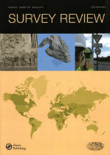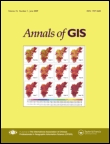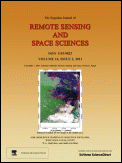
SURVEY REVIEW
metrics 2024
Advancing Knowledge Across Engineering and Earth Sciences
Introduction
SURVEY REVIEW is a distinguished journal published by Taylor & Francis Ltd, focusing on a diverse range of disciplines including Civil and Structural Engineering, Computers in Earth Sciences, and Earth and Planetary Sciences. With an ISSN of 0039-6265 and an E-ISSN of 1752-2706, this journal has been a vital resource for scholarly communication since its inception in 1963. Positioned within the Q2 and Q3 quartile categories according to the latest rankings, it is recognized for its significant contributions to advancing knowledge in multiple fields, specifically holding a rank of 64/159 in Earth and Planetary Sciences and 32/73 in Computers in Earth Sciences. Researchers, professionals, and students benefit from its critical insights into complex engineering and scientific challenges. Although SURVEY REVIEW is not open access, it remains a highly cited journal, making it an essential avenue for disseminating pivotal findings that impact both academia and industry practices.
Metrics 2024
 0.36
0.36 1.20
1.20 1.20
1.20 34
34Metrics History
Rank 2024
Scopus
IF (Web Of Science)
JCI (Web Of Science)
Quartile History
Similar Journals

International Journal of Spatial Data Infrastructures Research
Advancing Geospatial Knowledge for a Sustainable FutureThe International Journal of Spatial Data Infrastructures Research is a prestigious, open-access publication dedicated to advancing knowledge in the field of spatial data infrastructures. Published by the European Commission, Joint Research Centre, this journal has been a vital resource since its inception in 2006, promoting innovative research that informs policy and practice in geographic information systems and spatial data management. With a robust commitment to open access, the journal ensures that critical findings are readily available to researchers, professionals, and students globally, fostering a collaborative environment for the development of spatial technologies. The journal's unique focus on spatial data infrastructures makes it an essential platform for sharing empirical studies, theoretical advancements, and practical applications, ultimately driving the evolution of smart, sustainable geospatial solutions.

Revista de Teledeteccion
Illuminating the path of remote sensing research.Revista de Teledeteccion, published by UNIV POLITECNICA VALENCIA, EDITORIAL UPV, is a leading Open Access journal dedicated to the interdisciplinary field of remote sensing and its applications. Since its inception in 2010, this journal has provided a vital platform for researchers, professionals, and students to disseminate groundbreaking findings, foster collaboration, and engage with contemporary challenges in Earth and Planetary Sciences as well as Geography, Planning, and Development. With a Q3 ranking in both fields as of 2023, it serves as an essential resource for advancing knowledge and innovative practices in hi-tech remote sensing methodologies. The journal covers a broad spectrum of topics, from satellite imaging techniques to environmental monitoring, making it an invaluable asset for those interested in harnessing remote sensing technologies to address real-world issues. The editorial office is located in Valencia, Spain, and the journal aims to bridge the gap between theoretical research and practical application, enriching the scientific community's understanding and capabilities in this dynamic domain.

Annals of GIS
Connecting Research and Real-World ApplicationsWelcome to the Annals of GIS, a leading academic journal published by Taylor & Francis Ltd, dedicated to advancing the field of Geographic Information Science and its applications. With an ISSN of 1947-5683 and an E-ISSN of 1947-5691, this Open Access journal has been ensuring wide accessibility since 2019, thereby bolstering the dissemination of knowledge in areas such as remote sensing, spatial analysis, and geoinformatics. Hailing from the United Kingdom, the journal ranks impressively within its categories, achieving a Q2 status in Computer Science Applications and a prestigious Q1 ranking in Earth and Planetary Sciences for 2023, placing it in the top 10% among its peers. With a focus on innovative research spanning from 2009 to 2024, the Annals of GIS serves as a vital platform for researchers, professionals, and students alike, providing insights and fostering discussions that push the boundaries of geographic technologies and their real-world applications.

ISPRS International Journal of Geo-Information
Exploring the intersections of geography and innovation.ISPRS International Journal of Geo-Information, published by MDPI, stands at the forefront of the field of geospatial sciences, contributing valuable knowledge and research insights since its inception in 2012. This open access journal, which boasts an impressive collection of articles that emphasize the integration of geographic information systems (GIS) in Earth and planetary sciences, currently achieves a remarkable standing, with a 2023 impact factor ranking in the Q1 category for both Earth and Planetary Sciences and Geography, Planning and Development. Researchers and professionals engaged in the study of spatial data, remote sensing, and innovative geoinformation technologies will find the journal an essential resource, offering diverse perspectives and methodologies. With its open access model, the journal aims to promote the dissemination of knowledge globally, fostering collaboration among scholars while pushing the boundaries of research in geoinformation disciplines. The journal is based in Switzerland and is well-positioned to contribute significantly to the understanding and application of geospatial data for societal advancements.

Advances in Geodesy and Geoinformation
Advancing Knowledge in Geodesy and GeoinformationAdvances in Geodesy and Geoinformation is a pioneering journal published by the Polish Academy of Sciences, dedicated to the dynamic fields of geodesy and geoinformation. With an ISSN of 2720-7242 and an E-ISSN of 2720-7242, it offers an open-access platform since 2022, making cutting-edge research readily accessible to a global audience. The journal aims to foster the dissemination of innovative methodologies, technologies, and applications in the realms of geospatial data and earth sciences. Researchers, professionals, and students alike can benefit from the high-quality articles that contribute to advancing knowledge in this critical area, bridging theoretical insights and practical solutions. Situated in the heart of Poland, at PL Defilad 1, Warszawa, the journal not only reflects the nation's academic rigor but also positions itself as a crucial hub for international collaboration and knowledge exchange in geodesy and geoinformation.

GEOGRAPHICAL REVIEW
Unveiling Insights into Earth's Surface DynamicsGEOGRAPHICAL REVIEW, published by Taylor & Francis Inc, is a premier academic journal recognized for its influential contributions to the fields of geography and earth-surface processes. With an ISSN of 0016-7428 and an E-ISSN of 1931-0846, this journal has established itself as a vital resource for researchers, professionals, and students alike. The journal maintains a strong reputation with a Q1 ranking in both Earth-Surface Processes and Geography, Planning and Development, reflecting its scholarly impact and relevance in the academic community. Additionally, it holds a notable position in Scopus rankings, placing #181 out of 821 in Social Sciences and #45 out of 179 in Earth and Planetary Sciences. Although it is not open access, the GEOGRAPHICAL REVIEW remains essential for those seeking to expand their understanding of spatial analysis and environmental processes from its historical inception in 1969 to its ongoing publications through 2024. Explore rigorous research articles, critical reviews, and innovative studies that shape the discourse in geography and earth sciences today.

Remote Sensing
Transforming Data into Insight: The Future of Remote SensingRemote Sensing is a highly esteemed journal published by MDPI, dedicated to the domain of Earth and Planetary Sciences. With an impressive impact factor reflected in its rank of #16 out of 195 in the general Earth and Planetary Sciences category, this journal achieves a commendable 92nd percentile among its peers, indicating its significant contribution to the field. Since its inception in 2009 as an Open Access journal, it has enabled researchers, professionals, and students from around the globe to access high-quality, peer-reviewed articles that delve into the latest advancements in remote sensing technologies, methodologies, and applications. Based in Switzerland, Remote Sensing serves as a vital platform for disseminating innovative research that supports and enhances our understanding of Earth's processes and environments, ensuring scientific knowledge remains freely accessible and impactful.

Revue Internationale de Geomatique
Connecting Disciplines Through Geospatial InnovationRevue Internationale de Geomatique (ISSN: 1260-5875, E-ISSN: 2116-7060) is a prestigious journal published by TECH SCIENCE PRESS, dedicated to advancing the field of geomatics. This journal serves as a vital platform for disseminating significant research findings, cutting-edge methodologies, and innovative applications within the realm of spatial data and technology. With an emphasis on interdisciplinary studies, it fosters collaboration among researchers, professionals, and students across various domains, including environmental science, urban planning, and geographic information systems (GIS). Although not an open-access journal, Revue Internationale de Geomatique maintains a rigorous peer-review process ensuring the publication of high-quality articles that contribute to the evolving landscape of geomatics. Given its relevance and commitment to scholarly excellence, this journal is a crucial resource for advancing knowledge and practices in the ever-growing field of spatial information science.

Egyptian Journal of Remote Sensing and Space Sciences
Pioneering Research for a Deeper Understanding of Our UniverseThe Egyptian Journal of Remote Sensing and Space Sciences, published by Elsevier, is a premier open-access journal dedicated to advancing the fields of Remote Sensing and Space Sciences. Since its inception, the journal has gained a prominent reputation, currently holding a prestigious Q1 ranking in Earth and Planetary Sciences and placing within the top 10% of its field according to Scopus metrics. With an ISSN of 1110-9823 and an E-ISSN of 2090-2476, the journal features a diverse range of scholarly articles that explore both theoretical and practical aspects of remote sensing technologies and space science innovations, thus appealing to researchers, professionals, and students alike. Established in 2003 and fully transitioning to an open-access model in 2010, the journal aims to disseminate knowledge and foster collaboration across the globe by providing wider accessibility to groundbreaking research findings. Its commitment to quality and innovation is a catalyst for intellectual development in these dynamic and evolving disciplines.

Boletim de Ciencias Geodesicas
Exploring New Horizons in Geodesy and Planetary StudiesBoletim de Ciências Geodésicas is an esteemed academic journal published by the Universidade Federal do Paraná within its Centro Politécnico. Focused on the dynamic field of Earth and Planetary Sciences, this Open Access journal has been a pivotal resource since 1997, fostering the dissemination of critical research and innovative methodologies. With an impact factor indicative of its relevance in the discipline, Boletim de Ciências Geodésicas ranks in the Q3 quartile for Earth and Planetary Sciences as of 2023, showcasing its commitment to quality scholarship in a competitive field. Researchers and students alike will benefit from access to cutting-edge findings, given its broad scope that encompasses various aspects of geodesy and related sciences. The journal's convergence of research from 2005 to 2024 ensures that it remains at the forefront of emerging trends and fundamental developments in the discipline, further enhancing its esteemed reputation in the academic community.